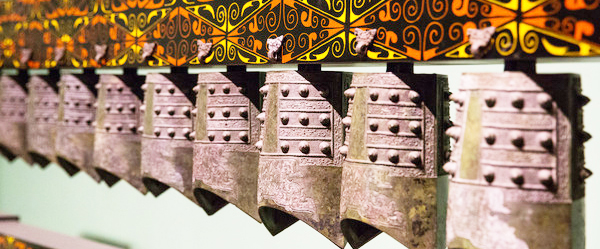Archeology provides insight for ancient music studies

Bronze chimes of the Warring States Period (475 BC-221 BC)
Ritual (li) and music (yue) culture is a prominent feature of Chinese civilization, as one can see from the fact that archeological discoveries of the Bronze Age are mainly bronze weapons and tools in other countries, while in China they are mainly sacrificial vessels and musical instruments.
Li originally refers to ceremonies giving sacrifice to gods, while yue stands for a musical instrument. In ancient times, sacrificial ceremonies were often accompanied by music, dance and singing.
In the 11th century BC, the Western Zhou Dynasty (c. 1100 -c. 771 BC) set up a rather complete ritual and musical system, to promote ethical and moral principles, and maintain social order.
The ritual and musical culture sustained the Zhou Dynasty (c. 1100-256 BC) for over 800 years, and laid the foundation for Chinese civilization. It provides an important theoretical basis and standards of value for ancient Chinese culture, and is what distinguishes Chinese civilization from other ancient civilizations.
In Chinese music history, there are few ancient musical scores handed down, and modern people hardly know how to play these scores, which complicates the study music history.
However, over the past four decades, musical relics, like chimes of the Warring States Period (475 -221 BC) discovered by archeologists in Sui county of Hubei Province, have enabled us to gain a new understanding of China’s tone system in ancient times.
Through translation and interpretation of ancient scores, like famous Chinese poet, composer and calligrapher of the Song Dynasty (960-1279) Jiang Baishi’s songs, and Dunhuang Pipa scores, we can add to our knowledge of music history.
Ancient music discoveries can also serve as live materials for studying music history. For example, transcripts of Xi’an drum music scores show that drum music peaked in the Ming (1368–1644) and Qing (1616-1911) dynasties. However, judging from its score patterns and script, and structures of music, its history can be dated back to the Tang (618-907) and Song dynasties.
Documents and records cannot give a full picture of real activities of ancient people, but unearthed relics can provide a supplement in this respect. Archeology of music, as an independent specialized discipline with modern significance, not only has methodological and academic theoretical values, but also has historical value in the following four aspects.
First, it can verify what has been revealed in historical documents. For example, a relatively complete set of goldstone musical instruments was unearthed in Suizhou, Hubei Province. These instruments are displayed with three facets facing outside, while documents unearthed at the same place record that the grave is for a head of one vassal state. Both the display pattern and the identification of the owner of the tomb is consistent with what has been written in Rites of Zhou, an ancient ritual text of Confucianism.
Second, it can rectify the incorrect records. The Records of the Grand Historian (Shi Ji) recorded that during the reign of Emperor Wu of Han (156-87 BC), the highest music bureau Yuefu was alredy set up to manage music and dancing activities. Nevertheless, in 1976, one bronze artifact unearthed in Mausoleum of the First Qin Emperor in Lintong, Shaanxi Province with inscription on the bell bottom saying Yuefu can be traced back to the Qin Dynasty (221-206 BC).
Third, it can tell things not recorded in documents. In the 1970s, archeologists of music discovered the music theory of dual tone and its adoption in ancient musical activities, according to changes in patterns of shapes and structures as well as ornamentation on bronze chimes from the Pre-Qin period, and rules of acoustics tested on them.
Fourth, it creates the “pre-history.” Archeologists found a large quantity of musical ruins from cultural remains of China’s pre-historical period. For example, several dozen bone flutes were unearthed at Neolithic Age sites in Jiahu village of Wuyang county, Henan Province, which moves back the date of China’s musical history to about 8,000 years ago.
Cheng Xu and Wang Xia are from the Shaanxi History Museum and Northwest University of Political Science and Law respectively.
